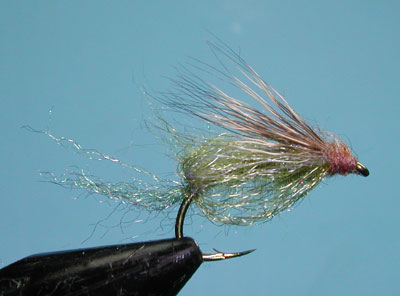Notes:
 This pupa pattern was developed by Gary LaFontaine around 1974 subsequent to a three year period in which
Gary used Scuba gear to study caddis within the Big Hole River of Montana. This fly pattern represents the caddis once it is in the
surface film. Gary noticed that caddis pupa were vulnerable only when the pupa was cutting itself free from it's cocoon and under
the surface layer where it splits it's pupal shuck. Gary found that only rarely will a trout feed or chase the pupa during it's time
of ascent. When the caddis pupa cuts from it's cocoon, there is a 15-20 second period in which the pupa drifts along the bottom
generating gas to fill the sheath around it's body. This gas produces a shimmering effect to the pupa. The ability to mimic this
shimmer was critical to Gary's pattern and he accomplished that effect by using Antron fibers developed by DuPont in 1973. Antron is a
trilobal fiber-yarn that is resistant to matting and has the ability to hold air bubbles within water. By utilizing the Antron for the
underbody and a sparse overbody, Gary was able to accomplish the gas-attracting qualities of the fly and the translucency required.
Gary noticed that while this emergent pupa pattern is within the surface film, the overbody will develop at trail of small bubbles
that also acts as an attractor to the fly. Ralph Cutter in his book, "Fish Food" (2005) suggests coating the fly with powdered floatant
as a means of creating bubbles around the body. He applies a split shot to compensate for the additional floatation. This pupa pattern was developed by Gary LaFontaine around 1974 subsequent to a three year period in which
Gary used Scuba gear to study caddis within the Big Hole River of Montana. This fly pattern represents the caddis once it is in the
surface film. Gary noticed that caddis pupa were vulnerable only when the pupa was cutting itself free from it's cocoon and under
the surface layer where it splits it's pupal shuck. Gary found that only rarely will a trout feed or chase the pupa during it's time
of ascent. When the caddis pupa cuts from it's cocoon, there is a 15-20 second period in which the pupa drifts along the bottom
generating gas to fill the sheath around it's body. This gas produces a shimmering effect to the pupa. The ability to mimic this
shimmer was critical to Gary's pattern and he accomplished that effect by using Antron fibers developed by DuPont in 1973. Antron is a
trilobal fiber-yarn that is resistant to matting and has the ability to hold air bubbles within water. By utilizing the Antron for the
underbody and a sparse overbody, Gary was able to accomplish the gas-attracting qualities of the fly and the translucency required.
Gary noticed that while this emergent pupa pattern is within the surface film, the overbody will develop at trail of small bubbles
that also acts as an attractor to the fly. Ralph Cutter in his book, "Fish Food" (2005) suggests coating the fly with powdered floatant
as a means of creating bubbles around the body. He applies a split shot to compensate for the additional floatation.
The Emergent Sparkle Pupa can be tied in many colors. The original Sparkle Yarn that Gary used was a blend of a particular color and
clear Antron. Clear Antron is no longer available, so many tiers will create a blend using White Antron. Eric Slagle, a quide from
Montana, wrote an excellent article on using Antron Dubbing color blends in Fly Tyer , Spring 2006. He would use the dubbing
for the overbody as well as the underbody. I find that the yarn is much easier to use for the overbody and use the dubbing blend for
the underbody and shuck. For the Sierras, Brown/Green are preferred during the months of April through September. The Brown/Orange is
an excellent October Caddis pattern during the months of September and October. Usually the pattern is fished as a dead drift, although
Gary usually liked to use some short mends while it was drifting. |


